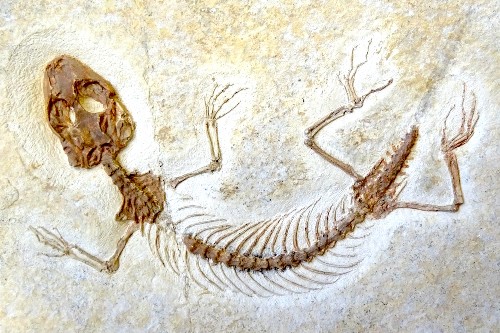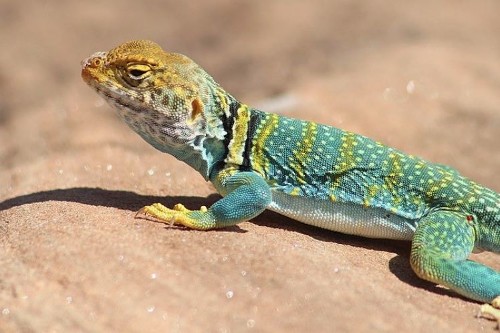
The fossil of Jurassic lizard Eichstaettisaurus. Jorge Herrera Flores

A collared lizard posing on a rock in Colorado. Pahcal123 under CC BY-SA 4.0 license
Scientists have found that a key modern group of reptiles that includes lizards and snakes - known as squamates - diverged in the Jurassic period, 50 million years earlier than previously thought.
New research published today in eLife by scientists from the Institut Català de Paleontologia Miquel Crusafont (ICP) and the University of Bristol challenges the current consensus that the radiation of squamates happened in the Cretaceous period. This was when many terrestrial tetrapod groups like mammals, lizards and birds, apparently underwent a great diversification during the so-called Cretaceous Terrestrial Revolution, triggered by the rise of flowering plants.
Now, a new study, led by Dr Arnau Bolet, palaeontologist at the Institut Català de Paleontologia Miquel Crusafont and the University of Bristol, implies a much earlier radiation of squamates. Along with colleagues from Bristol's School of Earth Sciences, Prof Michael Benton, Dr Tom Stubbs and Jorge Herrera-Flores, their research concludes that this group of reptiles probably achieved a diverse array of adaptations in the Jurassic (between 201 and 145 Myr.), long before current estimates. "Even though Jurassic squamates are rare, reconstructed evolutionary trees show that all the main specializations of squamates evolved then, and it's possible to distinguish adaptations of geckoes, iguanas, skinks, worm lizards, and snakes some 50 million years earlier than had been thought", explains Michael Benton, co-author of the research. "But how could the scarce Jurassic fossils suggest an early burst in evolution? The key is in their anatomy."
The few Jurassic squamates do not show primitive morphologies as would be expected, but they relate directly to the diverse modern groups. "Instead of finding a suite of generalized lizards on the stem of the squamate tree, what we found in the Jurassic were the first representatives of many modern groups, showing advanced morphological features", says Arnau Bolet, lead author of the article.
The observed times of divergence, morphospace plots and evolutionary rates, all suggest that the Jurassic was a time of innovation in squamate evolution, during which the bases of the success of the group were established. According to these results, the apparent sudden increase in diversity observed in the Cretaceous could be related to an improved fossil record, capable of recording a larger number of species, or to a burst of origins of new species related to the new kinds of forests and insects.
The Squamata is the largest order of reptiles, including lizards, snakes and worm lizards. Squamates are all cold-blooded, and their skins are covered by horny scales. They are key parts of modern terrestrial faunas, especially in warmer climates, with an astonishing diversity of more than 10,000 species. However, understanding the evolutionary paths that forged their success are still poorly understood.
Establishing the timing and mode of radiation of squamates is key for not only understanding the dynamics of terrestrial ecosystems in the Mesozoic, but also for deciphering how the group achieved an astonishing diversity of more than 10,000 species, only rivalled by birds among tetrapods.
Paper:
'The Jurassic rise of squamates as supported by lepidosaur disparity and evolutionary rates' by Arnau Bolet et al in eLife.






